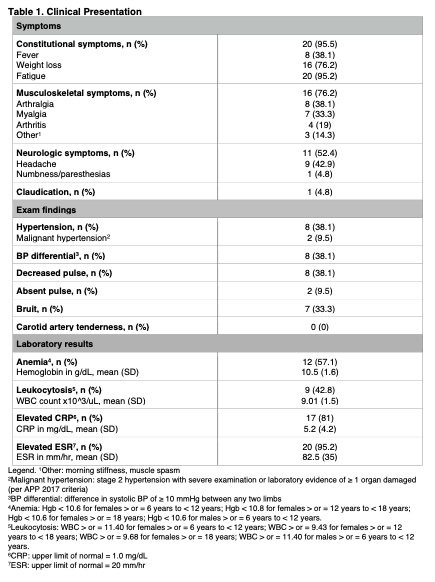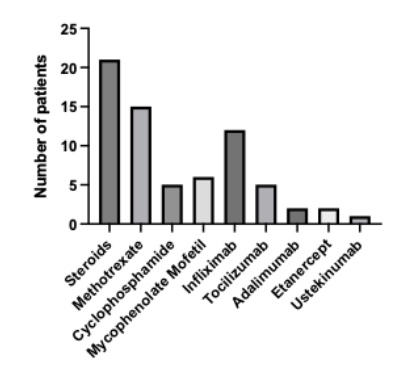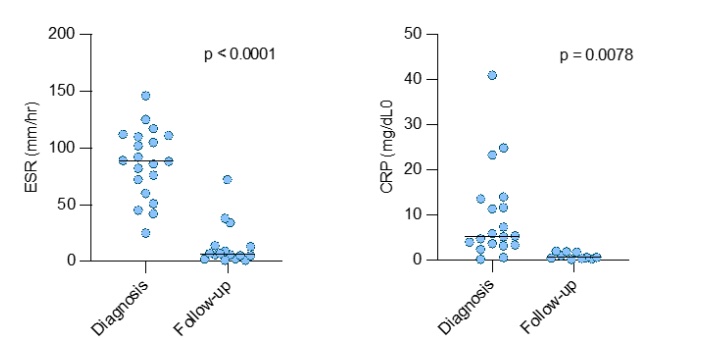Session Information
Date: Monday, November 13, 2023
Title: (1221–1255) Pediatric Rheumatology – Clinical Poster II: Connective Tissue Disease
Session Type: Poster Session B
Session Time: 9:00AM-11:00AM
Background/Purpose: Takayasu arteritis (TA) is a rare granulomatous vasculitis that affects large vessels, including the aorta, its major branches, and the pulmonary artery. Data on the presentation and clinical course of pediatric TA are limited, and children present with different clinical features than their adult counterparts.
Methods: With institutional review board approval, a retrospective cohort study of children who were diagnosed with TA at two large pediatric centers between 2005-2022 and 2016-2023 was performed. Data were abstracted from the electronic medical record. Patient demographics, presenting symptoms and signs, imaging findings, and management data were evaluated using standard descriptive statistics.
Results: Twenty-one patients were included. The majority were female (90.45%), with a mean age at diagnosis of 13.5 years (range 9-17). Most were Hispanic or Latino (71.4%). Diagnosis occurred a median of 4 months following symptoms onset (IQR 1-15), and the mean follow-up period was 38 months (range 5-112). The most prevalent symptoms at initial presentation were constitutional (95.5%), with fatigue being almost universally present (Table 1). A history of claudication was only elicited from one patient at presentation. Over half (54.5%) presented with hypertension, BP differential, and/or decreased pulses. All but one patient had an elevated ESR (mean 82.5 mm/hr, range 25-146), and all but four had an elevated CRP (mean 5.2, range 0.2-13.6) (Table 1). All patients had imaging evidence of aortic involvement, including the abdominal (76.2%), ascending thoracic (71.4%), and descending thoracic (66.7%) segments. Seven patients (33.3%) had renal artery stenosis. All patients were initiated on systemic corticosteroids at diagnosis. The most common initial steroid-sparing immunomodulatory regimen included a combination of methotrexate and infliximab (42.9%). Eighty-one percent were treated with a biologic DMARD (bDMARD) at some point (Figure 1). Many patients switched steroid-sparing agents throughout their disease course. Reasons for addition or change of therapy included poor disease control or flare, inability to wean steroids, new disease manifestations, adverse effects, and patient preference. Five patients (23.8%) required surgical management. At the most recent follow-up visit, 10 patients remained on steroids. Five patients were still symptomatic. One patient achieved drug-free clinical remission. There was a statistically significant decrease in ESR (p< 0.0001) and CRP (p=0.0078) from the initial to final visit (Figure 2).
Conclusion: Like prior pediatric studies, patients in our cohort presented predominantly with constitutional symptoms, musculoskeletal involvement, hypertension, and elevated inflammatory markers. bDMARDs were introduced earlier than in previously reported cohorts. Our cohort was demographically different from other pediatric case series as we report majority Hispanic/Latino patients. While many patients were asymptomatic at the last follow-up, approximately half still required steroids for disease control.
To cite this abstract in AMA style:
Altaffer A, Ciaglia K, Sloan E, De Guzman M. Clinical Manifestations and Management of Takayasu Arteritis: A Multicenter Pediatric Cohort [abstract]. Arthritis Rheumatol. 2023; 75 (suppl 9). https://acrabstracts.org/abstract/clinical-manifestations-and-management-of-takayasu-arteritis-a-multicenter-pediatric-cohort/. Accessed .« Back to ACR Convergence 2023
ACR Meeting Abstracts - https://acrabstracts.org/abstract/clinical-manifestations-and-management-of-takayasu-arteritis-a-multicenter-pediatric-cohort/



